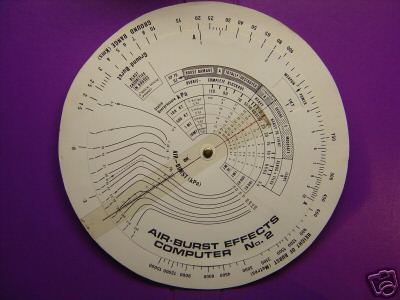The Air-Burst Effects Computer No.1 was designed by Blundell Rules Ltd. (BRL) of Weymouth. It is made of plastic and is 10 inches in diameter. I think they were issued to the UK’s Royal Observer Corps [ROC] during the Cold War. The ROC manned a national network of bunkers equipped to provide government with information on targets and weapons used in the event of a nuclear attack on the UK [see Wikipedia article on Square Leg].
Unlike the ROC’s Nuclear Weapons Effects Computers the Air-Burst Effects Computer focused solely on the effects of a nuclear explosion occurring above the ground (Air-Burst). Though on its back it states that ‘This computer also gives the blast effects of ground-burst weapons as obtained from the Nuclear Weapon Effects Computers No. 1 and 2’.
Nuclear planners assumed that surface [or sub surface] bursts would be used against hardened targets such as missile silos or command bunkers. As the diagrams below show they are less effective against cities. They also produce much more radioactive fallout than an air burst because soil and rock is drawn up into the mushroom cloud.
The photograph below shows a later version of the air-burst effects computer. I don’t have one of these.
For more posts about Cold War calculators click on the Cold War Calculators category on the right.
Counterfactuals
If events had gone slightly differently –
- October 15–October 28, 1962: The Cuban Missile Crisis is often considered as having been the closest to a nuclear exchange. During the crisis a Soviet submarine nearly launched a nuclear-tipped torpedo in response to depth charging by the US Navy. The launch was prevented by an officer named Vasili Arkhipov).
- November 9, 1979: The United States made emergency retaliation preparations after NORAD saw on-screen indications that a full-scale Soviet attack had been launched. No attempt was made to use the “red telephone” hotline to clarify the situation with the USSR and it was not until early-warning radar systems confirmed no such launch had taken place that NORAD realized that a computer system test had caused the display errors. A senator inside the NORAD facility at the time described an atmosphere of absolute panic.
- September 26, 1983: A false alarm occurred on the Soviet nuclear early warning system, showing the launch of American Minuteman ICBMs from bases in the United States. An erroneous retaliatory nuclear attack on the United States and its Western allies was prevented by Stanislav Yevgrafovich Petrov, an officer of the Soviet Air Defence Forces, who intuited the scale and recent system upgrades meant the system had simply had a malfunction (which would be borne out by later investigations).
- November 2–11, 1983: Amid deteriorating relations between the Soviet Union and the United States the Able Archer 83 military drill for NATO’s nuclear-release procedures was treated by some Politburo members as a ruse of war. Nuclear weapons and air forces were placed on alert in East Germany and Poland before the exercise ended.


![Air-Burst Effects Computer No. 1 [Front]](https://calculating.wordpress.com/wp-content/uploads/2012/05/air-burst-effects-computer-no-1-front.jpg?w=500&h=494)
![Air-Burst Effects Computer No. 1 [Back]](https://calculating.wordpress.com/wp-content/uploads/2012/05/air-burst-effects-computer-no-1-back.jpg?w=500&h=498)


